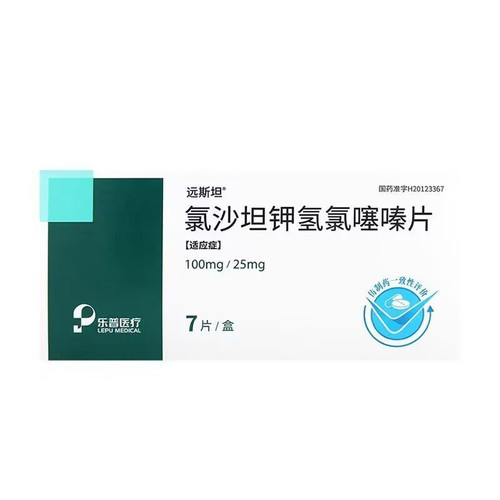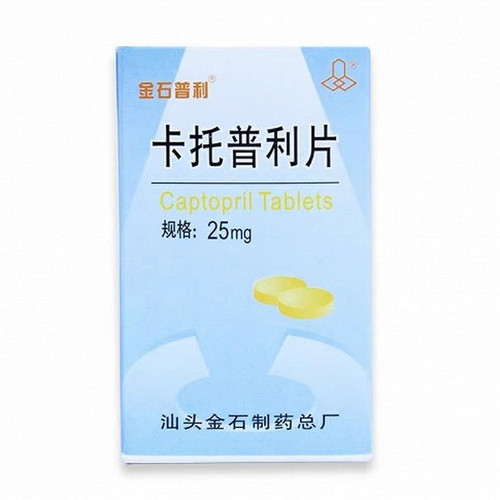Product Overview
[Drug Name]
Generic Name: Hydrochlorothiazide Tablets
Trade Name: Yunpeng
English Name: Hydrochlorothiazide Tablets
Chinese Pinyin: Hydrochlorothiazide Tablets
[Ingredients]
This product contains 93.0% to 107.0% of the labeled amount of hydrochlorothiazide (C7H8ClN3O4S2).
[Appearance]
This product is a white tablet.
[Indications]
1. Edema Disorders: Excretes excess sodium and water from the body, reduces extracellular fluid volume, and eliminates edema. Common conditions include congestive heart failure, ascites due to cirrhosis, nephrotic syndrome, edema due to acute and chronic nephritis, early-stage chronic renal failure, and sodium and water retention caused by corticosteroid and estrogen therapy. 2. Hypertension: Can be used alone or in combination with other antihypertensive drugs, primarily for the treatment of essential hypertension. 3. Central or nephrogenic diabetes insipidus. 4. Nephrolithiasis: Primarily used to prevent stones formed by calcium salts. 【Dosage and Administration】 1. Commonly used drug for adults, oral. ① For the treatment of edematous diseases, 25-50 mg (1-2 tablets) each time, 1-2 times a day, or every other day, or 3-5 days a week; ② For the treatment of hypertension, 25-100 mg (1-4 tablets) per day, divided into 1-2 doses, and the dose is adjusted according to the antihypertensive effect. 1. Common dosage for children, 1-2 mg/kg per day or 30-60 mg/m2 per day, divided into 1-2 doses, and the dose is adjusted according to the efficacy. The dose for infants under 6 months old can reach 3 mg/kg per day. 【Adverse Reactions】 Most adverse reactions are related to the dose and course of treatment. (1) Side effects caused by water and electrolyte disorders are more common. Hypokalemia is more likely to occur due to the potassium excretion effect of thiazide diuretics. Long-term potassium deficiency can damage the renal tubules. Severe potassium loss can cause vacuolar changes in the renal tubular epithelium and cause severe tachyarrhythmias and other ectopic heart rates. Hypochloremic alkalosis or hypochloremic and hypokalemic alkalosis. Thiazides, especially hydrochlorothiazide, often significantly increase chloride excretion. In addition, hyponatremia is not uncommon, leading to central nervous system symptoms and aggravated renal damage. Dehydration causes a decrease in blood volume and renal blood flow, which can also cause a decrease in glomerular filtration rate. Common clinical reactions to the above-mentioned water and electrolyte disorders include dry mouth, thirst, muscle cramps, nausea, vomiting, and extreme fatigue and weakness. (2) Hyperglycemia. This drug can reduce glucose tolerance and increase blood sugar, which may be related to the inhibition of insulin release. (3) Hyperuricemia. It interferes with the excretion of uric acid by the renal tubules and can rarely induce gout attacks. Since there is usually no joint pain, hyperuricemia is easily overlooked. (4) Allergic reactions, such as rash, urticaria, etc., are relatively rare. (5) Leukopenia or deficiency, thrombocytopenic purpura, etc. are also rare. (6) Others, such as cholecystitis, pancreatitis, sexual dysfunction, photosensitivity, color vision disorder, etc., but they are rare.
[Contraindications]
Not yet clear.
[Precautions]
(1) Cross-allergy: Cross-reaction with sulfonamides, furosemide, bumetanide, and carbonic anhydrase inhibitors. (2) Interference with diagnosis: May cause decreased glucose tolerance, increased blood sugar, urine sugar, blood bilirubin, blood calcium, blood uric acid, blood cholesterol, triglycerides, low-density lipoprotein concentrations, and decreased blood magnesium, potassium, sodium, and urine calcium. (3) Use with caution in the following situations: ① Patients with anuria or severe renal impairment, as this type of drug has poor efficacy and high doses may lead to drug accumulation and increased toxicity; ② Diabetes; ③ Hyperuricemia or a history of gout; ④ Severe liver damage, where water and electrolyte imbalances may induce hepatic coma; ⑤ Hypercalcemia; ⑥ Hyponatremia; ⑦ Lupus erythematosus, which may aggravate the condition or induce activity; ⑧ Pancreatitis; ⑨ Sympathectomy (enhanced antihypertensive effect); ⑩ Infants with jaundice. (4) Follow-up examinations: ① Blood electrolytes; ② Blood sugar; ③ Blood uric acid; ④ Blood muscle enzymes, urea nitrogen; ⑤ Blood pressure. (5) Medication should be started at the minimum effective dose to reduce the occurrence of side effects and reduce reflex renin and aldosterone secretion. (6) Patients with a tendency to hypokalemia should be given potassium supplements or used in combination with potassium-sparing diuretics as appropriate.
[Use in special populations]
Children's precautions: Use with caution in infants with jaundice, as this type of drug can increase blood bilirubin.
Precautions during pregnancy and lactation: 1. It can pass through the placental barrier. It has no preventive effect on hypertension syndrome. Therefore, pregnant women should use it with caution. 2. It should not be taken by breastfeeding women.Precautions for the elderly: Elderly people are more likely to develop hypotension, electrolyte imbalance and renal damage when using this type of drug.
[Drug Interactions]
(1) Adrenocortical hormone, adrenocorticotropic hormone, estrogen, and amphotericin B (intravenous administration) can reduce the diuretic effect of this drug and increase the chance of electrolyte imbalance, especially hypokalemia. (2) Non-steroidal anti-inflammatory analgesics, especially indomethacin, can reduce the diuretic effect of this drug, which is related to the former's inhibition of prostaglandin synthesis. (3) When used in combination with sympathomimetic amines, the diuretic effect is weakened. (4) Cholestyramine (cholestyramine) can reduce the absorption of this drug by the gastrointestinal tract, so this drug should be taken 1 hour before or 4 hours after oral administration of cholestyramine. (5) When used in combination with dopamine, the diuretic effect is enhanced. (6) When used in combination with antihypertensive drugs, the diuretic and antihypertensive effects are enhanced. (7) When used in combination with anti-gout drugs, the latter should be adjusted in dose. (8) It weakens the effect of anticoagulants, mainly because the body's plasma volume decreases after diuresis, the level of coagulation factors in the blood increases, and diuresis improves the blood supply to the liver, increasing the synthesis of coagulation factors. (9) It reduces the effect of hypoglycemic drugs. (10) When digitalis drugs, amiodarone, etc. are used in combination with this drug, caution should be taken to prevent side effects caused by hypokalemia. (11) When used in combination with lithium preparations, this drug can reduce the kidney's clearance of lithium and increase the nephrotoxicity of lithium. (12) When used in combination with this drug, the conversion of methenamine to formaldehyde is inhibited, and the efficacy is reduced. (13) Enhances the effect of non-depolarizing muscle relaxants and is related to a decrease in blood potassium. (14) When used in combination with sodium bicarbonate, the chance of developing hypochloremic alkalosis increases.
[Pharmacological Actions]
(1) Effects on water and electrolyte excretion. ① Diuretic effect, increased urinary excretion of sodium, potassium, chloride, phosphorus and magnesium ions, while reduced urinary calcium excretion. The mechanism of action of this type of drug is mainly to inhibit the reabsorption of sodium chloride in the distal tubule proximal tubule (less severe), thereby increasing the Na+-K+ exchange in the distal tubule and collecting duct, and increasing K+ secretion. Its mechanism of action is not yet fully understood. This type of drug can inhibit carbonic anhydrase activity to varying degrees, which can explain its effect on the proximal tubule. This type of drug can also inhibit phosphodiesterase activity, reduce the tubular uptake of fatty acids and mitochondrial oxygen consumption, thereby inhibiting the active reabsorption of Na+ and Cl- by the tubule. ② Antihypertensive effect. In addition to the diuretic and natriuretic effects, there may also be extrarenal mechanisms involved in lowering blood pressure, which may be to increase the excretion of Na+ by the gastrointestinal tract. (2) Effects on renal hemodynamics and glomerular filtration function. Due to the reduced reabsorption of water and Na+ by the renal tubules, the pressure in the renal tubules increases, and the water and Na+ flowing through the distal convoluted tubules increase, stimulating the macula densa through the tubule-glomerular reflex, increasing the secretion of renin and angiotensin in the kidneys, causing renal vasoconstriction, decreased renal blood flow, contraction of the glomerular afferent and efferent arterioles, and decreased glomerular filtration rate. The decrease in renal blood flow and glomerular filtration rate, as well as the lack of effect on the loop of Henle, are the main reasons why the diuretic effect of this type of drug is far inferior to that of loop diuretics.
[Storage] Store in a dark place and sealed.
[Specifications] 25mg*100 tablets
[Packaging specifications] Bottle
[Expiration date] 36 months
[Approval Number] National Medicine Standard H14020796
[Manufacturer] Shanxi Yunpeng Pharmaceutical Co., Ltd.







